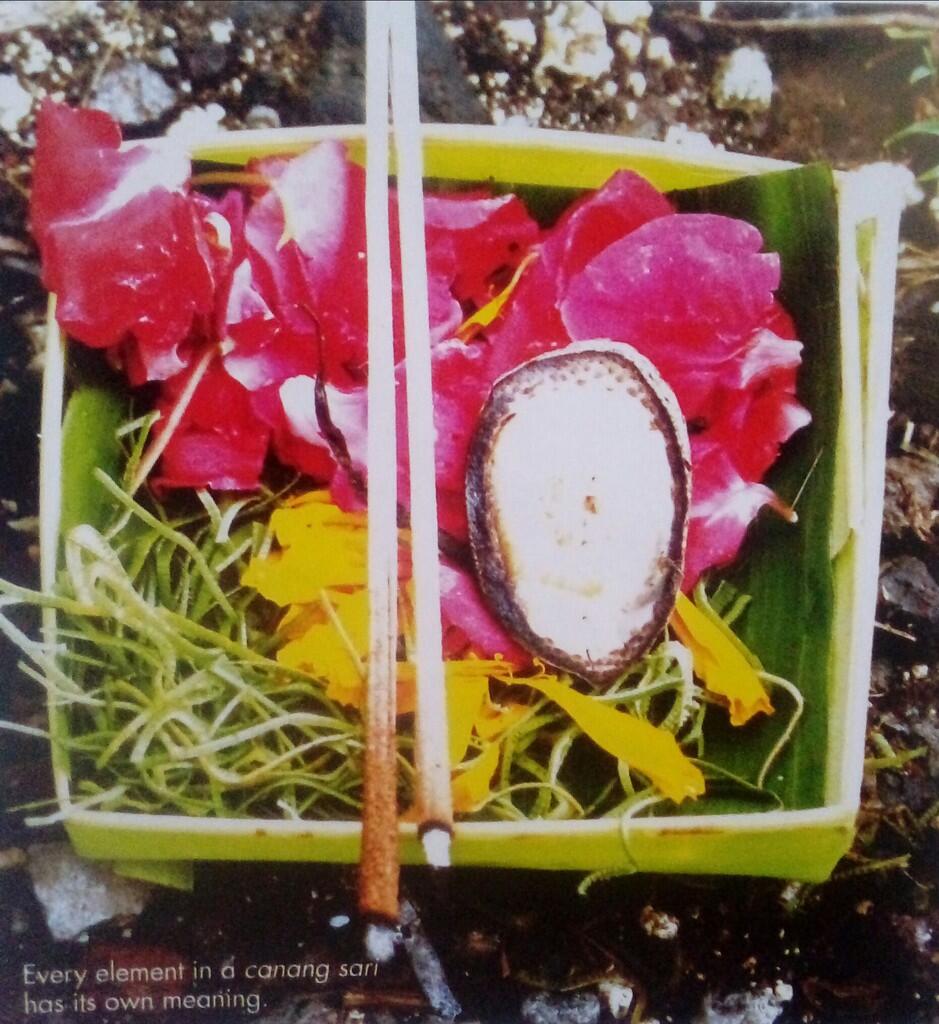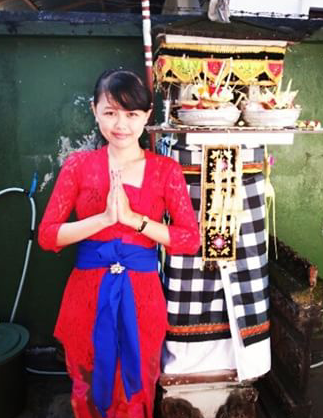- Beranda
- Komunitas
- Food & Travel
- Travellers
Symbols of Bali, Learn all about canang sari and Balinese black and white
TS
kawiyana13
Symbols of Bali, Learn all about canang sari and Balinese black and white

Commonly formed in a square-shaped tray made of woven-coconut leaves filled with flowers, canang sari or canang would be the first item that visitors would easily associate with Bali. This daily offering can be seen everywhere; in a temple, on the street, on the beach or on the top of cashier counter in a shop. The woven-tray is usually filled with multi-colored flowers and topped with an incense stick. Some even add specific elements; a bakery would put some crumbles of bread while owners of warung nasi campur (food joints) put a lump of rice and chicken as a part of their offering.
Originated from Sanskrit, the word canang actually consists of two words; “ca” means beautiful and “nang” means “purpose”. So, canang can be translated as a basket for a beautiful purpose.
Canang sari is made of two components- canang is the small palm-leaf basket, while sari is the essence. Each element in a canang sari has its own meaning is the peporosan or the core materials consist of betel leaf, lime gambier, tobacco and betel nuts which represent the three Hindu deities : Brahma (gambier), Vishnu (betel nuts), and Shiva (lime). Together they form Tri Murti, the combination of their power as a creator, a preserver, and a fuser respectively. The base tray called ceper is made of palm leaf, and is a symbol of Ardha Candra ( the earth and the moon). Raka-raka (any kind of fruits) are then placed and topped with sampian urasari (decoration made of coconut leaves) to symbolize the stars. And finally, multi-colored flowers are placed on top following certain cardinal directions.
Four different colors of petals fill the basket, not only to represent east, west, north and south, but also to symbolize a relationship with God. At the top of the compass, Vishnu is represented by blue or green flowers, while the white flowers on the east direction are for Iswara. On the south is a red flower for Brahma, and yellow is the color for the west for the Mahadeva. The offering is made complete with an amount of kepeng (old Chinese coint) or paper money on top. And then, incense is lit and holy water is sprinkled for prayers.
As a whole, canang sari symbolizes a form of gratitude to Sang Hyang Widhi Wasa (God) for peace and abundance blessings. The philosophy of canang sari is actually self-sacrifice as it takes time and effort to prepare them every day.
For a Balinese woman, it is an obligation to know how to make canang sari and other offerings (called “mejejaitan”) because making offerings are just as important as cooking, taking care of the children and cleaning the house. However, this tradition has slowly changed in this modern era as people now can easily buy a ready-made canang sari from traditional markets. Even so, the core essence and the symbolical meaning remain intact.
Another symbol of Balinese tradition is Kain Poleng or saput poleng, the black and white checkered fabric that is usually wrapped around ancient trees, statues, temples or even kulkul (a traditional Balinese bamboo musical instrument that is used to summon villagers to gather).

Kain Poleng often receives a negative connoatation among visitors of Bali as it is believed that a spirit resides in the objects wrapped by the fabric. Although it is true, there is more to Kain Poleng than a “container” of bad spirits or demons. In the Balinese culture Kain Poleng is a symbol of “Rwa Bhineda” which refers to the duality and the balance of nature.
Originated from two word- “Rwa” means two and “Bhineda” means different-Kain Poleng signifies the duality contained in an object. The Balinese believe that everything that exists in the world, both the microcosmic or macrocosmic world, has to contrasting forces that need to be equally respected, like day and night, and sadness and happiness. This concept also means that the world revolves around Skala (the visible world) and Niskala (the invisible world). And in order for humans to live in harmony, all these contrasting dualities need to be in balance and we know the same philosophy of Kain Poleng are Yin and Yang.
Kain Poleng symbolizes this concept perfectly. The black color of the fabric symbolizes the dark, while the white symbolizes the light. The pattern represents duality, and the whole fabric serves as a reminder for us all to keep the balance in harmony.
So the next time you see tree or a statue being wrapped in Kain Poleng, fear not for the demon with in the object, but take it as a reminder to acknowledge the good and bad within yourself. And always maintain the balance to create harmony within yourself, between you and other people as well as the nature and the unseen spirits.
Source : wisataunikbali.com
Polling
Poll ini sudah ditutup. - 0 suara
Adakah informasi yang didapat dari artikel ini?
Ada
0%
Tidak
0%
0
1.8K
1
Komentar yang asik ya
Urutan
Terbaru
Terlama
Komentar yang asik ya
Komunitas Pilihan